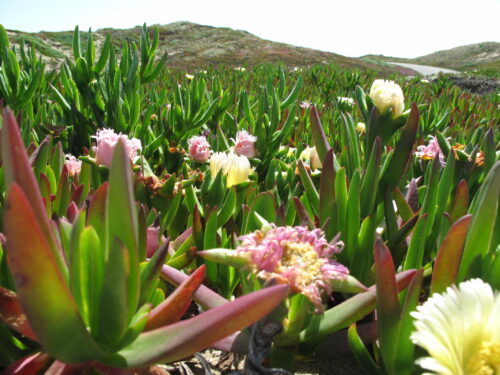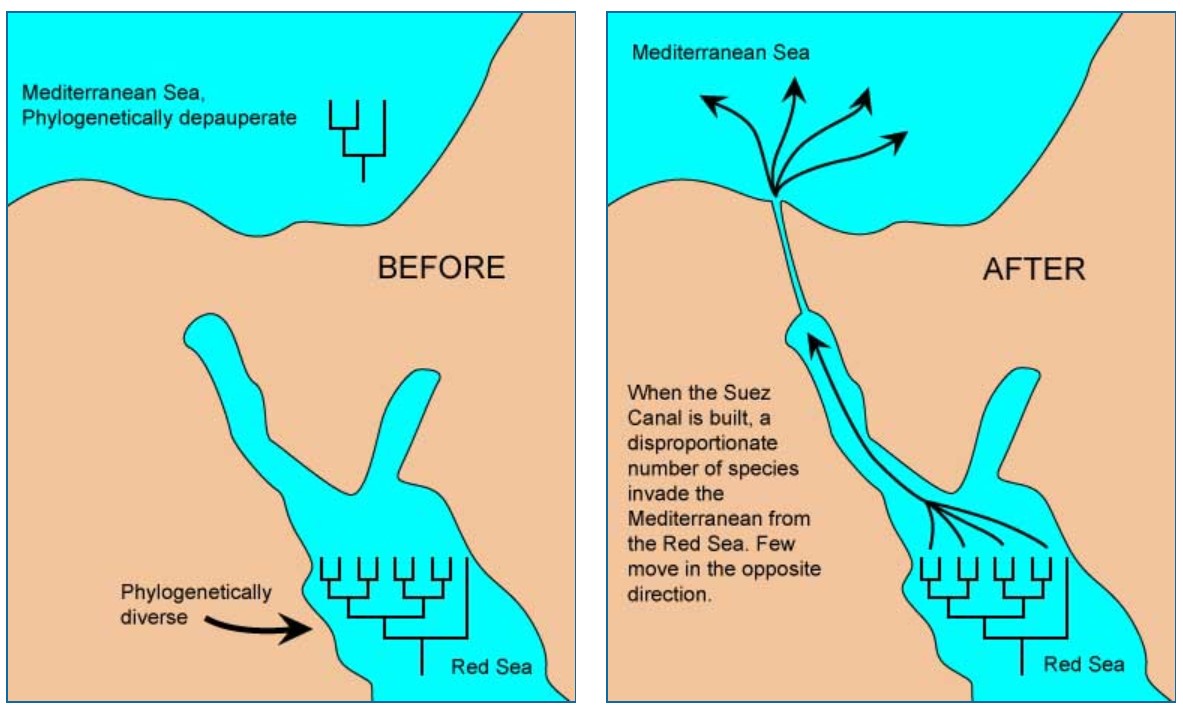
Imagine a quintessential scene from a Golden State vacation: standing on the bluffs off Highway One, taking in a view of the beach below and a Pacific sunset on the horizon. It’s classic California. Only what’s beneath your feet on that cliff is not Californian at all. The succulent highway iceplant (Mesembryanthemum crystallinum), a native of South Africa, was first introduced to California in the early 1900s and has since spread up and down the coast, competing with native plants for resources and suppressing the growth of native seedlings. And it’s not just California. Invasive species cause serious environmental disturbances all over the world: introduced pythons threaten native wildlife in the Everglades, invasive plants have changed regions of South Africa from grassland to scrub, foreign barnacles displace mussels and oysters on Europe’s northwestern coasts. In the U.S. alone, invasive species cause billions of dollars of damage each year and contribute to the threat faced by hundreds of endangered species. But what makes an invasive species in the first place? Plenty of organisms make it to new ground, but many just can’t hack it and die out or remain marginal, while other species take over. Biologists have proposed many hypotheses to explain the difference, but now new research (based on a very old idea!) suggests that evolution can help us predict which introduced species are more likely to become problematic invasives.
Where's the evolution?
Potential explanations abound for why some species, which live peacefully in their home ranges, take over when they reach a foreign ecosystem. Perhaps in their native ecosystems the problematic species are kept in check by predators that specialize on them; since the new ecosystem lacks these predators, the invader can run rampant. Or perhaps the invaders have weapons (e.g., defensive chemicals) that other species in their home ranges have already evolved protections against but to which the species in the new ecosystem are vulnerable. Or maybe the problem has something to do with the invaded ecosystem itself. Perhaps disturbed land makes an ecosystem susceptible to invasion. Or perhaps the invaded ecosystem has untapped resources of which the invading species can take advantage. These hypotheses all focus on the ecological factors that may contribute to invasions; however, the new idea is based on evolutionary history.
The idea originated with Darwin in On the Origin of Species. He proposed that some species’ evolutionary histories have shaped them to become more competitive than others. Given the same set of resources, some species may have evolved traits that are more effective at accumulating those amenities and using them to produce offspring. The new research elaborates on this basic idea. Specifically, the biologists highlighted two features of a species’ evolutionary history that might help make it into a super-competitor:
- Consistent environment. Lineages that have had plenty of time to experience natural selection and adaptation in one environment might wind up with a competitive edge. So species whose native habitats have been fairly constant through deep time may be more likely to become invasive when they arrive in a new environment.
- Competition. Lineages that have experienced strong selection over their evolutionary histories may have evolved more competitive traits. We’d expect the intensity of selection to increase when a lineage faces more competition—so a lineage that has long been surrounded by other new species (i.e., “evolutionary experiments”) making life a little tougher may have experienced stronger natural selection and wound up having traits that allow them to outcompete natives in a new ecosystem.
For example, the strawberry guava, a native of South America, fits this pattern. It has become invasive in the rainforests of the Hawaiian Islands, where it simply seems to be better at living in shady situations than the native understory species. Perhaps this has to do with the environments in which the Hawaiian natives and the strawberry guava evolved. Hawaii is geologically young in comparison to South America and cannot match the abundant diversity of (and inherent competition in) the South American tropics.
The idea here is that evolution doesn’t produce perfection. Just because natural selection has shaped one species to survive in a particular environment doesn’t mean that it is “the best” or perfectly adapted. Natural selection produces traits that are “good enough” to survive—and another species from elsewhere might be even better at it.
To test their hypothesis, the researchers would need to know which foreign species came from regions with long consistent environments and plenty of competition, and which came from regions lacking these characteristics. Unfortunately, both of these features are difficult to measure. Instead, the researchers focused on phylogenetic diversity—that is, the number of unique species in a region and the breadth of their distribution on the tree of life. Regions with more species and with more distantly related species have a higher level of phylogenetic diversity than other areas. Phylogenetic diversity is a good stand-in for environmental consistency because we’d expect regions with historically stable environments to contain lots of species that diverged from one another in the distant (as opposed to the recent) past. Furthermore, phylogenetic diversity can also help us get a handle on the level of competition present in a region, because we’d expect areas that are home to lots of distantly related species to force those species to compete for limited resources. So, regions of high phylogenetic diversity should also have high levels of environmental consistency and competition—and, according to the hypothesis, be more likely to produce invasive species than other regions.
The researchers studied three regions that have had many introductions of foreign species: Eastern North America, the Czech Republic, and New Zealand. In these regions, species from other places are categorized as either invasive (i.e., tend to spread and take over) or noninvasive. Based on the new hypothesis, the researchers expected that foreign species from regions with high phylogenetic diversity would be more likely to be invasive than species from regions with low phylogenetic diversity, which would be more likely to be harmless visitors—and in fact, this is exactly what they observed. To test the idea in a different way, the researchers studied how building the Suez, Panama, and Erie Canals affected the biota on each side of the canal. In all three of these cases, large, previously distinct ecosystems were connected by a passageway that allowed species to move in both directions. The researchers reasoned that if their idea were correct, in each case, species from the side of the canal with higher phylogenetic diversity should tend to invade the ecosystem with lower phylogenetic diversity. Their results lend further credence to the hypothesis. For example, the construction of the Suez Canal resulted in an out-of-proportion number species from the phylogenetically diverse Red Sea invading the less diverse Mediterranean, just as we’d expect based on the hypothesis.
For now, this is an idea in need of more testing. Additional research could help biologists figure out how important a factor superior competitive ability resulting from a species’ evolutionary history is in contributing to the epidemic of biological invasions in our increasingly connected world. If this has facilitated invasions in the past, it could help us determine how best to prevent destructive invasions in the future—for example, by setting up extra protections against importing species from regions of high phylogenetic diversity. The idea could also provide clues about how to most effectively deal with these invaders once they take hold. Darwin’s ideas continue to shape not just how we view the biological world, but how we solve biological problems.
Primary literature:
- Fridley, J. D., and Sax, D. F. (2014). The imbalance of nature: revisiting a Darwinian framework for invasion biology. Global Ecology and Biogeography. 23: 1157-1166. Read it »
News articles:
- A summary of the research from the New York Times
- A take on the new research from the Brown Daily Herald
Understanding Evolution resources:
- The basics of how natural selection works to produce adaptations
- A review of common misconceptions about natural selection and adaptations
- A summary of the many ways in which evolutionary theory can inform conservation efforts
Background information from Understanding Global Change:
-
- In your own words, explain the new hypothesis regarding invasive species and why the hypothesis is inherently evolutionary.
- Why would a consistent environment encourage the evolution of more competitive traits? Be sure to include the concept of natural selection in your answer.
- In your own words, explain what phylogenetic diversity is.
- According to the new hypothesis regarding invasive species, what should we expect to observe regarding invasive species if two regions with similar levels of phylogenetic diversity were connected to one another?
- Advanced: One hypothesis regarding invasive species suggests that, in their native ecosystems, invasive species are kept in check by predators that specialize on them; because the new ecosystem lacks these predators, the invader can run rampant. Is this hypothesis strictly ecological, strictly evolutionary, or both? Explain your answer.
- Advanced: Is phylogenetic diversity a good proxy for environmental consistency and level of competition? Explain your answer.
- Teach about natural selection: In this classroom activity for grades 9-16, students simulate breeding bunnies to show the impact that genetics can have on the evolution of a population of organisms.
- Teach about phylogeny: This short video for grades 6-12 introduces basic concepts in phylogenetics and provides a model to help understand lineage-splitting.
- Teach about phylogenetic diversity: This news brief for grades 9-16 explains how we can use phylogenetic diversity to set conservation priorities.
- Fridley, J. D., and Sax, D. F. (2014). The imbalance of nature: revisiting a Darwinian framework for invasion biology. Global Ecology and Biogeography. 23: 1157-1166.
- U.S. Fish and Wildlife Service. (2012). The cost of invasive species. Retrieved November 3, 2014 from U.S. Fish and Wildlife Service: http://www.fws.gov/verobeach/PythonPDF/CostofInvasivesFactSheet.pdf

